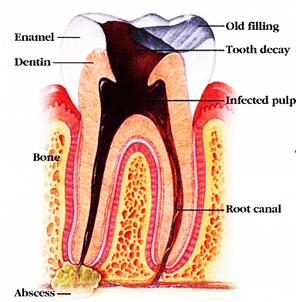Root Canal
Home » Root Canal
WHAT IS A ROOT CANAL?
At the core of the tooth is soft tissue (otherwise known as pulp). The hollow area that houses this soft tissue contains a space towards the top of the tooth called the pulp chamber. This pulp chamber is connected to the root of the tooth via pipe-like canals, giving rise to the term “root canal”. The blood vessels in these canals provide nutrition to the tooth. Occasionally, the internal soft tissue of the tooth becomes infected and can result in a serious infection if left untreated. Root canal treatment should take place before the infection gets too serious.

Request an Appointment
We invite you to visit our dental office where you will receive a gently, compassionate care from Dr. Shannon and his staff
INFECTED/INFLAMED PULP TISSUE
Technically “root canal” is not the name of the procedure but refers instead simply to the thin tubes that connect the pulp chamber and the tip of the tooth’s root. In fact, the procedure that laymen refer to as a “root canal” is actually known as a pulpectomy to dentists. A pulpectomy is an endodontic treatment to cure an infected root canal. In the old days, damage to the core of a tooth usually meant it had to be removed. Today, however, a “root canal” procedure (or pulpectomy) disinfects and refills the inside of the tooth, thus preventing pain and limiting damage to the tooth.
Some indications of the need for root canal treatment may be:
- Spontaneous pain or throbbing while biting.
- Sensitivity to hot and cold foods.
- Severe decay or an injury that creates an abscess (infection) in the bone.
Root Canal Therapy
When bacteria invades the nerve of the tooth, it can become irritated and die. When this happens, bacteria invade the center of the tooth and produce gases or pus which can result in a dental abscess. The abscess can become painful and cause facial swelling. If untreated it can lead to a very serious medical condition.
With modern advances in technique, root canal therapy is now quick and easy to perform. It is much more predictable and can usually be completed in one visit. The procedure seals the center of the tooth and allows it to function as it did prior to the nerve dying. Root canal therapy can cause teeth to become more brittle and therefore need to be crowned for protection. Root canal therapy allows retention of a tooth which would otherwise require extraction. Furthermore, it is much less expensive to save the tooth via root canal therapy than to replace it with an implant or fixed bridge.
The pictures show an xray of a tooth with a dental abscess, what a root canal therapy looks likes on xray, and the bone heals following treatment:
| Mon | 8:00AM – 5:00PM |
| Tues | 8:00AM – 5:00PM |
| Wed | 8:00AM – 5:00PM |
| Thurs | 7:00AM – 3:00PM |
| Fri | Closed |
| Sat | Closed |
| Sun | Closed |
- 13354 Coursey BLVD. Baton Rouge, LA 70816
- (225) 752-8348
- Fax: (225) 752-8352
- shannon.kelli@rocketmail.com

